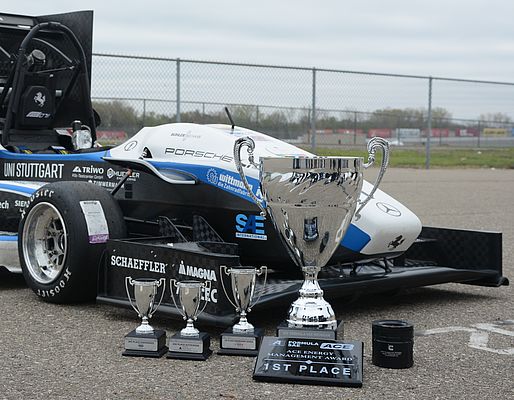ACE Control Inc. recently awarded the racing team of the University of Stuttgart, Germany, with the 2019 ACE Energy Management Award during the races of Formula SAE at the Michigan Speedway International in the USA, the first international racing competition - launched in 1981 - for students and race cars built by their teams. The team recently won the overall ranking at the Formula SAE for the fourth time in a row. This year, the committed team from Swabia also took the ACE Energy Management Award home to Germany.
Innovative energy management solutions
Awarded for the second time in 2019 by ACE Controls Inc., the prize is worth a total of 2,250 US dollars and honors innovative energy management solutions. Chris Niemiec, Engineering Manager, North America, at ACE explains: “This can be in the form of vibration or motion control, impact damping, etc. We look for creativity, effectiveness and overall ‘wow’ factor from the application.” The team from Stuttgart prevailed in this student competition against more than 20 applicants. Second and third place were taken by race teams from universities in Montreal, Canada, and the University of Michigan, Dearborn.
At Michigan Speedway International, ACE's specialists not only provided teams with support at their own information booth, but they also visited many teams with other sponsors. "Enthusiasm in talking about the vehicles and teams is very high and the curiosity about how they can be optimized with our solutions is huge on both sides," says Larry Cavalloro, responsible for marketing in the USA. This is also because Formula SAE is not primarily concerned with developing the fastest cars.
Development of racing cars
In this race series, as well as in the European Formula Student, top performances in different sub-categories count. Here, the Stuttgart racing team sets standards. It stands out in the development of racing cars by consistent implementation of a lightweight construction. The related work was also the key to winning the ACE Energy Management Award. On the one hand, the German students were one of only a few teams to carry out practical analyses of the influence of vibrations on the performance and dynamics of their vehicle.
On the other hand, an innovative crash element made of carbon fiber composites and aramid was a central aspect of the safety concept of the Swabians. With the development of a carbon fiber aramid impact attenuator, they succeeded in developing an absorbent construction that weighs less than half of comparable elements and absorbs about 9,000 joules of energy. The resulting energy corresponds to the impact of a mass of 660 lb from a height of 8.2 ft. At the same time, the low weight of the attenuator ensures significantly improved handling and higher speeds of the car in curves and straights.
Peter Maderthaner, Subteam Director & Aero CFD of the team from Stuttgart, who received the award together with Anurag Ramarao Murali, responsible for Monocoque and Aero Structural Simulation: "We thank ACE for this award, which confirms our commitment to also continue with our simulations, analyses and studies before the actual contests to hopefully defend our US title in 2020."
























































